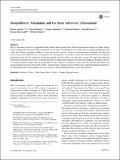Files in this item
Disequilibrium, adaptation, and the Norse settlement of Greenland
Item metadata
| dc.contributor.author | Jackson, Rowan | |
| dc.contributor.author | Arneborg, Jette | |
| dc.contributor.author | Dugmore, Andrew | |
| dc.contributor.author | Madsen, Christian | |
| dc.contributor.author | McGovern, Tom | |
| dc.contributor.author | Smiarowski, Konrad | |
| dc.contributor.author | Streeter, Richard | |
| dc.date.accessioned | 2018-09-17T12:30:08Z | |
| dc.date.available | 2018-09-17T12:30:08Z | |
| dc.date.issued | 2018-10 | |
| dc.identifier | 255747975 | |
| dc.identifier | 52a27170-1541-44e1-abd4-360712e9f852 | |
| dc.identifier | 85053548584 | |
| dc.identifier | 000446483500005 | |
| dc.identifier.citation | Jackson , R , Arneborg , J , Dugmore , A , Madsen , C , McGovern , T , Smiarowski , K & Streeter , R 2018 , ' Disequilibrium, adaptation, and the Norse settlement of Greenland ' , Human Ecology , vol. 46 , no. 5 , pp. 665-684 . https://doi.org/10.1007/s10745-018-0020-0 | en |
| dc.identifier.issn | 0300-7839 | |
| dc.identifier.other | ORCID: /0000-0003-2261-4540/work/64697932 | |
| dc.identifier.uri | https://hdl.handle.net/10023/16036 | |
| dc.description | This research was supported by the University of Edinburgh ExEDE Doctoral Training Studentship and NSF grant numbers 1202692 and 1140106. | en |
| dc.description.abstract | There is increasing evidence to suggest that arctic cultures and ecosystems have followed non-linear responses to climate change. Norse Scandinavian farmers introduced agriculture to sub-arctic Greenland in the late tenth century, creating synanthropic landscapes and utilising seasonally abundant marine and terrestrial resources. Using a niche-construction framework and data from recent survey work, studies of diet, and regional-scale climate proxies we examine the potential mismatch between this imported agricultural niche and the constraints of the environment from the tenth to the fifteenth centuries. We argue that landscape modification conformed the Norse to a Scandinavian style of agriculture throughout settlement, structuring and limiting the efficacy of seasonal hunting strategies. Recent climate data provide evidence of sustained cooling from the mid thirteenth century and climate variation from the early fifteenth century. Archaeological evidence suggests that the Norse made incremental adjustments to the changing sub-arctic environment, but were limited by cultural adaptations made in past environments. | |
| dc.format.extent | 20 | |
| dc.format.extent | 1886289 | |
| dc.language.iso | eng | |
| dc.relation.ispartof | Human Ecology | en |
| dc.subject | Greenland | en |
| dc.subject | Norse | en |
| dc.subject | Niche construction | en |
| dc.subject | Culture | en |
| dc.subject | Climate | en |
| dc.subject | Disequilibrium | en |
| dc.subject | GF Human ecology. Anthropogeography | en |
| dc.subject | 3rd-DAS | en |
| dc.subject | SDG 13 - Climate Action | en |
| dc.subject | SDG 14 - Life Below Water | en |
| dc.subject | SDG 15 - Life on Land | en |
| dc.subject.lcc | GF | en |
| dc.title | Disequilibrium, adaptation, and the Norse settlement of Greenland | en |
| dc.type | Journal article | en |
| dc.contributor.institution | University of St Andrews. Bell-Edwards Geographic Data Institute | en |
| dc.contributor.institution | University of St Andrews. School of Geography & Sustainable Development | en |
| dc.identifier.doi | https://doi.org/10.1007/s10745-018-0020-0 | |
| dc.description.status | Peer reviewed | en |
This item appears in the following Collection(s)
Items in the St Andrews Research Repository are protected by copyright, with all rights reserved, unless otherwise indicated.

